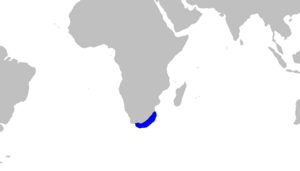Brown shyshark facts for kids
Quick facts for kids Brown shyshark |
|
|---|---|
 |
|
| Conservation status | |
| Scientific classification | |
| Genus: |
Haploblepharus
|
| Species: |
fuscus
|
 |
|
| Range of the brown shyshark | |
The brown shyshark (Haploblepharus fuscus) is a type of catshark. It's also known as the plain happy. This shark lives only in the shallow waters off South Africa. You can find it from Cape Agulhas to KwaZulu-Natal.
This shark lives on the ocean floor, usually over sandy or rocky areas. Brown shysharks can grow up to 73 cm (about 29 inches) long. They have a strong body, a wide, flat head, and a round snout. Most are plain brown, but some have faint "saddle" markings or light or dark spots. When this shark feels threatened, it curls into a circle. It puts its tail over its eyes, which is why it's called a "shyshark." It eats bony fishes and lobsters. Female shysharks lay pairs of egg capsules. The International Union for Conservation of Nature (IUCN) says this shark is a Vulnerable species. This means its population could be at risk.
Contents
Discovering the Brown Shyshark
Who Named This Shark?
The brown shyshark was first described by a South African ichthyologist (fish scientist) named James Leonard Brierley Smith. He wrote about it in 1950. He named it fuscus, which is a Latin word meaning "brown."
Where Was It Found?
The first brown shyshark studied was a 57 cm (22 inch) long adult male. It was caught off East London, South Africa. Scientists later studied its DNA to learn more about its family tree. They found that the brown shyshark is closely related to the dark shyshark.
What Does the Brown Shyshark Look Like?
Size and Shape
The brown shyshark is a small shark. It can grow up to 73 cm (about 29 inches) long. It has a stocky body and a short, wide head. Its snout is blunt and flat on top.
Eyes and Nose
Its eyes are large and oval-shaped. They have a small protective third eyelid. The shark's nostrils are very big. They have large, triangular flaps of skin that reach its mouth. These flaps cover deep grooves that connect the nostrils to the mouth.
Teeth and Gills
The brown shyshark has small grooves at the corners of its mouth. Its teeth have a main point and two smaller points on the sides. It has five pairs of gill slits. These are located on the upper sides of its body.
Fins and Skin
The first dorsal fin (back fin) is located far behind its pelvic fins. The second dorsal fin is behind its anal fin. Its pectoral fins (side fins) are medium-sized. All its fins are similar in size. The caudal fin (tail fin) is short and wide. It has a small notch near the tip of the upper part.
The shark's skin is thick. It is covered in small, leaf-like scales called dermal denticles. These scales are well-calcified, making them strong.
Coloration
The brown shyshark is plain brown on top and white underneath. However, some sharks have faint darker markings that look like saddles. Others might have black or white spots.
Where Do Brown Shysharks Live?
Their Home Waters
The brown shyshark lives only along the coast of South Africa. You can find it in the Western and Eastern Cape Provinces. It also lives in southern KwaZulu-Natal Province.
Habitat Preferences
This shark usually stays close to the ocean bottom. It prefers sandy areas or rocky reefs. It lives in shallow waters, from the intertidal zone (where the tide goes in and out) down to about 35 meters (115 feet) deep. Sometimes, it has been seen as deep as 133 meters (436 feet).
Sharing Their Home
The brown shyshark's home range overlaps with another shyshark, the puffadder shyshark. In areas where they both live, the brown shyshark tends to stay in shallower waters. The puffadder shyshark prefers deeper waters offshore.
Life and Habits of the Brown Shyshark
A Bottom-Dwelling Shark
The brown shyshark is a calm, bottom-dwelling species. Studies have shown that these sharks don't move very far. One study found that tagged sharks moved no more than 8 km (5 miles) from where they were first tagged.
What They Eat
This shark is known to eat bony fishes and lobsters.
Why Are They "Shy"?
Like other shysharks, the brown shyshark has a unique way of reacting when it feels threatened. It curls into a ring shape, covering its eyes with its tail. This behavior is where the name "shyshark" comes from.
How They Reproduce
Brown shysharks reproduce by laying eggs. This is called oviparous reproduction. Females lay their egg capsules, often called "mermaid's purses," two at a time. In aquariums, some types of whelks (sea snails) have been seen piercing these egg cases. They then eat the yolk inside.
When They Grow Up
Male brown shysharks become ready to reproduce when they are about 68–69 cm (27–27.2 inches) long. Females reach maturity when they are about 60–61 cm (23.6–24 inches) long.
Brown Shysharks and Humans
Harmless to People
The brown shyshark is not dangerous to humans. People do not hunt them for commercial fishing because they are small. However, they can sometimes be caught by accident as bycatch in fishing nets.
Recreational Fishing
Anglers (people who fish for fun) sometimes catch brown shysharks. They are often seen as a minor nuisance. Usually, they are released or killed if caught.
Conservation Status
The International Union for Conservation of Nature (IUCN) has listed the brown shyshark as a Vulnerable species. Even though there are many of them in some places, their small home range makes them sensitive. More fishing or pollution could harm the entire population.
In Captivity
Brown shysharks can adapt well to living in aquariums.


